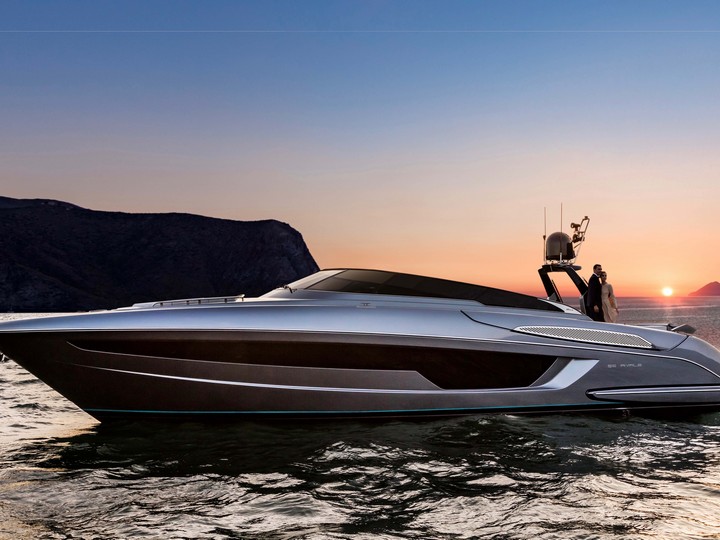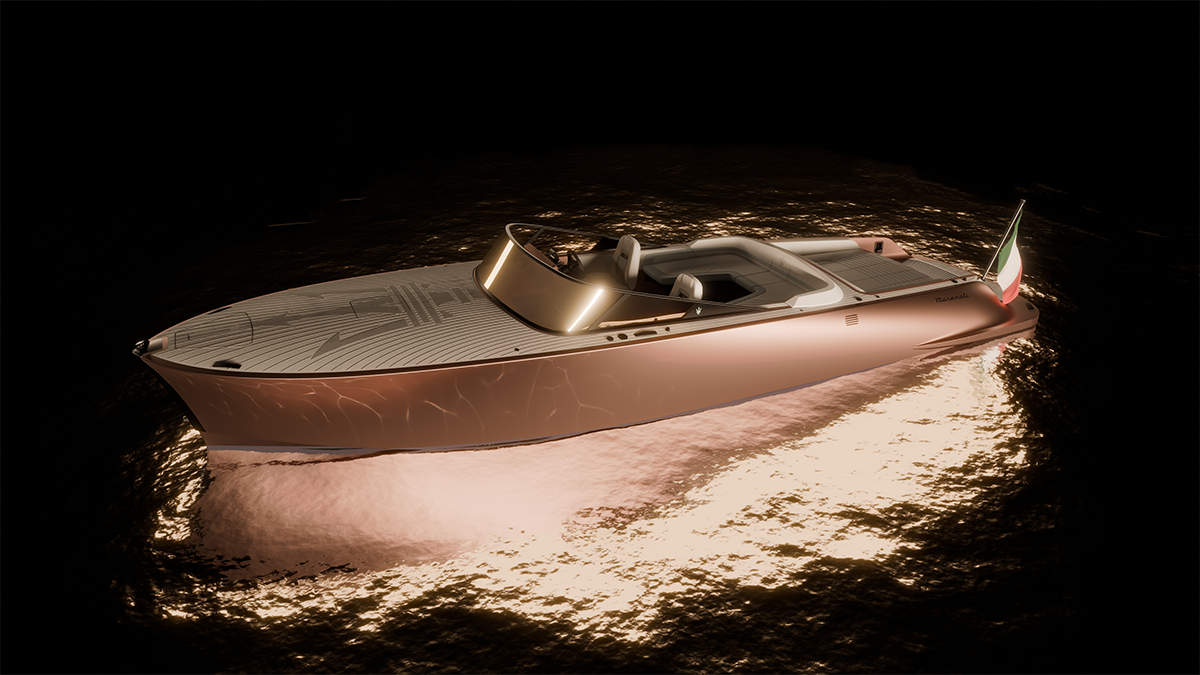
Twelve of the finest boats to emerge from the Cannes and Monaco shows
More than 100 new yachts — from tenders to gigayachts — were introduced in two of the French Riviera’s most beautiful harbours.
Related articles
The Cannes Yachting Festival and Monaco Yacht Show have marked the official starts of the yachting season, with more than 100 new yachts — from tenders to gigayachts — introduced in two of the French Riviera’s most beautiful harbors. Cannes has always been the launching point for midsized yachts, and this year was no different. The show saw 84 yachts making their global debuts. Cannes also saw many hulls in excess of 100 feet this year, with noteworthy premieres like the Azimut 35 Metri, Custom Line Navetta 33, and Sunseeker 131, among many others.
Given the dozens of launches, most observers agreed that this was the best Cannes yacht show in more than a decade.
The Monaco boat show had an entirely different character. Monte Carlo’s harbor accommodates fewer vessels, but the 100-plus superyachts gathered there carried an awe-inspiring presence — a collection of the best-designed custom yachts gathered in one place, with the opulence of Monaco’s hills as the backdrop. Beyond the harbor, 300-foot-plus gigayachts too large for the show were anchored offshore. Like Cannes, Monaco was considered a banner show, with visitors from all over the world coming to see yachting’s finest collection.
Here are a dozen samplings of the best of both boat shows.
Azimut 35 Metri

The Azimut 35 Metri, shown at both Cannes and Monaco, is the new flagship of the Azimut Grande line. The Stefano Righini design has an edgy, angular exterior with dark windows that define the profile and a raised pilothouse that gives the superstructure the sleek look of a performance motor yacht rather than the boxier dimensions of a typical flybridge vessel. The 115-footer’s carbon-fibre superstructure and hardtop — rarities on yachts of this size — add structural integrity while dramatically lowering weight. That allowed Righini to design a “wide-body” interior without compromising its 25.5-knot top speed. At 10 knots, the 35 Metri has a range of 2,414 kilometres.
Floor-to-ceiling windows in the saloon flood the interior with natural light. The master suite also has floor-to-ceiling windows, including one that folds outward to become a private terrace. Features like the three-floor spiral staircase with backlit onyx steps, lifting platform on the foredeck, and option to add another 30-square-metre deck are features more for the gigayacht than the typical 100-footer. Azimut always pushes the design envelope, but this is a significant leap forward for the Italian builder.
Custom Line Navetta 33

Custom Line’s new Navetta 33 is a radical reinvention of the typical Italian Navetta-style boat. Instead of a cumbersome, trawler-like vessel, the four-deck Custom Line is sleek and ship-like in appearance, with all the features one can expect on a modern superyacht. The design team — which included Piero Ferrari of the famed sports car dynasty, Studio Zuccon International Project, and the Ferretti Group’s in-house engineering group — came up with a bold new concept that mates a seaworthy hull to a contemporary exterior that includes a full-featured flybridge (with lounges, wet bar, sunbeds, and swimming pool), a generous foredeck with lounges and sun beds, and two exterior aft cockpit spaces on the main and upper decks.
Navettas have traditionally been designed with simple, down-home styles, but this 108-footer’s interior is contemporary Italian, with natural black-walnut paneling covering the walls along with colorful modern artwork and stainless trim. The lower saloon (there is a second saloon on the deck above) encompasses about a third of the 110-foot hull length, so the social and dining areas have an unusually large sense of space. The forward master suite is nearly the same length and includes a walk-in closet, full-beam bathroom, and desk and vanity in the bedroom.
The sense of opulence in this master is rarely seen on yachts this size and are certainly not the traditional Navetta style. But the Navetta 33 does share traits with its predecessors, including a blue-water hull that has a 3,218-kilometre range with twin 1,043 kW MAN engines. The Dual-Mode Transom is a great benefit for long-distance cruisers; the rear swim platform drops below the water, flooding the garage for simple tender launching. It also creates a submersible platform if guests want access to the water from the now-expanded beach club area. The revolution will continue next year when Custom Line launches its 138-foot Navetta 42.
Riva Rivale 56

Riva’s new 56 Rivale is the ultimate ocean cruiser, with a high, protected bow and planing hull that can reach 38 knots with twin 895 kW MAN engines. The intricate, open cockpit is exceptionally well-designed. The double-size white sun bed at the stern, surrounded by teak stairs on either side, carries the Rivale’s simple, elegant look, while, further forward, two white lounges sit along the port side of the hull. A wet bar and exterior galley are along the other side. Like all Rivas, details distinguish the brand.
The Rivale’s helm station has an all-glass, touchscreen cockpit, stainless steering wheel with a white leather cover, throttles placed discreetly along the side, and air-conditioning vents for hot weather. The slender, black roll bar with a black radome on top is equal parts artistic and functional. Teak defines the cockpit and walkways to the bow, leading to another double sun bed. Even the 56’s bow is fine art, with a sculpted steel horn and teak panel on the foredeck with a beautiful angular pattern.
The Rivale 56 also has technical details that are complex to engineer but do not impede the simple look. The swim platform submerges beneath the water to allow the tender to be unloaded. When the platform is down, steps designed into the port-side hull allow people to climb up from the water. This simple but ingenious solution allowed Riva to do away with the ladder that typically clutters the stern. In the same way, an electrohydraulic bimini top slides in and out from the sides for instant shade, disappearing when not needed.
The Rivale’s interior is defined by dark mahogany, lacquered hardwoods, dark leather coverings, and white fabrics that convey a sense of richness without being flashy. The two staterooms employ similar colour schemes and include white-leather-covered headboards and dark leather bedside tables. The crew quarters can be replaced by a third guest stateroom by owners who operate their own Rivali. The beautiful Riva was shown at both Cannes and Monaco.
Sunseeker Predator 57 MK II

U.K. builder Sunseeker introduced its Predator 57 MK II at the Cannes show, displaying exactly why the Predator series remains unique in the yachting sector. Aggressive, elegant, and fast, the 57 MK II is defined by the curves of its hardtop and extensive use of glass. Even the hardtop has an opening sunroof that covers almost a third of the overhead space. It lets in wind and sun on beautiful days, but the 57 MK II buttons up nicely for total climate control. Sunseeker added pillar-less windows to its previous 57 (the MK II stands for Mark 2), allowing for sweeping views of the ocean.
The patio door to the cockpit has also been engineered to drop down into the sole, turning the entire deck into a large open space. The mini beach club at the transom — with its integrated barbecue, overhead shower, and fold-down seating — is an option that adds a new component of user-friendliness to the swim platform. Belowdecks, the full-beam master suite and forward VIP stateroom are both en suite, along with a third stateroom with twins. The 57 MK II also has a captain’s quarters. Living up to its name, the Predator can reach 40 knots, with the ability to carve turns like a much smaller speedboat.
Mulder Delta One

Delta One’s vertical bow, high bulwarks, and protected foredeck have an oceangoing, almost ship-like look, and for a 118-foot yacht, it is impressive. The vessel is one of the few yachts its size with transatlantic range, and on its North Sea trials, the yacht successfully battled 4-metre-high waves and Force Six winds. Despite the weather, Mulder’s all-aluminum yacht still managed to reach a top end of 16.8 knots, with a 15-knot cruising speed.
The fast-displacement hull by Van Oossanen Naval Architects is designed for tough conditions and long distances, but U.K. designer Claydon Reeves made sure Delta One could dish out maximum R&R in sunny climes. “We pushed hard to redefine what can be achieved in a vessel under 300 gross tons,” said Mike Reeves, one of the designers.
On the sky bridge, an eight-person Jacuzzi, wet bar, dining table, sun beds, and lounges are protected by a hardtop for jaunts through the Mediterranean and Caribbean. The designers also made full use of the yacht’s 8-metre beam, particularly in the open-plan saloon and forward in the master suite. With walk-in closets and an en-suite bathroom, the master also offers private access to a seating area in the bow. Floor-to-ceiling windows in the saloon and dining area enhance natural light, and a foldout terrace adds another meaning to alfresco dining. Another differentiator on this yacht is the full-headroom beach club with its own bar and day head. For its size, Delta One will be a great example of what can be accomplished in the mini-superyacht class.
ISA Clorinda

Clorinda was an important launch for the Italian ISA brand because it was the first to be built under its new owner, Palumbo Shipyards. A crossover between the older ISA Sport 120 and a fresh design by Enrico Gobbi, Clorinda has unusual details like glass inserts on the exteriors and a forward “solarium” that fills the saloon with light. The split-level master suite is also unusual for a 120-footer, with a large bedroom on the main deck and an en suite bathroom three steps down in the lower level. This design adds an important separation to the master, making it feel as if it should be on a larger yacht.
Clorinda’s three 16V 2000 M96 MTU engines are connected to twin KaMeWa water jets and a centreline booster to reach speeds up to 33 knots — light speed for a boat this size — and turn with the agility of a much smaller yacht. Clorinda made its debut in Cannes but continued to wow crowds at Monaco.
Lürssen Areti

Lürssen is known for stopping the show at Monaco, and this year it didn’t disappoint with the 279-foot Areti. Winch Design gave Areti a quasi-classical profile, with a high-riding forward section and tall radar tower on the sun deck. The hull is cream-coloured and balanced by the white superstructure and gray accents. Areti’s owner chose this colour scheme to match his previous yachts. Winch describes the design as “beach chic,” with private terraces in guest staterooms and a full-service spa that includes a sauna, hot tub, full-depth plunge pool, meditation area, and an “experience” shower with multi-temperature water jets, therapy lights, and aromatherapy scents. Lürssen built Areti to the Passenger Yacht Code (PYC), so the boat has eight staterooms and a full-beam master suite.
The owner’s suite also has its own private deck, complete with a Jacuzzi, sun bed, and breakfast table. Just steps away, Areti’s bow helipad also allows for easy ship-to-shore transfers for the owners and guests.
Feadship Aquarius

Feadship’s 302-foot Aquarius is one of those yachts that literally takes your breath away. The profile by Sinot Exclusive Yacht Design has an almost retro look with the sleek, pointed hull, but it also has elements of modern design, with through-hull windows and upper decks that look as if they’re floating above full-length panels of glass. The owner, a serial yacht owner and art lover, wanted Aquarius to be awash in as much natural light as possible — partly to create a bright environment but also to show off his private collection.
The owner’s suite has his-and-her bathrooms, a media room, and a private balcony, and the five other guest suites were built to exacting specifications. The owner also made sure his 31 crew members would be comfortably housed in 14 crew cabins, a captain’s stateroom, and two cabins for the owner’s staff.
Rossinavi Aurora

Aurora’s 161-foot-long exterior has incorporated design cues from the auto-racing world that, rather than being distractions, worked well with one of the most stunning, contemporary profiles at Monaco. The custom yacht from the drawing board of Fulvio De Simoni was designed for an owner who loves sport and adventure. That was clear from De Simoni’s exterior, which includes two “cuts” shaped like sports-car vents at the front of the yacht. Those sizable openings provide protection and privacy for the foredeck terrace, and just plain look cool.
The yacht also has two owner’s suites, each with balconies. Aurora has a sunbathing area that De Simoni called the “beach salon,” which includes a dining space and sun lounges. Designer Achille Salvagni created a modern interior with vibrant-colored furniture, curved sections of the ceiling, and large picture windows that work well with the race-car exterior.
Aurora is powered by twin 2,580 kW MTU diesel engines, giving it a speed of 21 knots, with a maximum cruising range of 7,038 kilometres at 12 knots.
Turquoise Razan

There is an almost otherworldly sense of lightness around Razan, the custom yacht by Turquoise. The 155-footer has an elegant profile, but the proliferation of whites and off-whites, both inside and out, truly define the vessel. In the saloon, London-based H2 Yacht Design used these colours on the walls, ceilings, marble, rugs, and even the glass cabinet beside the dining table. The impression is that of a bright but formal room that runs counter to the current trends of high-contrast and informal design.
The full-beam owner’s suite has the same sense of brightness and space as the saloon, with much of the same colour palette. Unusual features like a large soaking tub and sink beside the master’s floor-to-ceiling windows set Razan apart. Another standout feature is the transom beach-club gym. It sits at sea level just feet away from the water when the aft hatch is raised. Guests on the treadmill or exercise bike will have the most inspirational workouts, being so close to the ocean.
Benetti Seasense

Benetti’s Seasense is arguably one of the best of the best at Monaco this year. The 220-foot custom superyacht has one-of-a-kind features like the “Benetti Beach Concept” and an “indoor-outdoor” veranda. The Beach Concept features a large swimming pool — measuring 10 by 4.2 metres — that converts into a basketball court with specially designed carbon-fibre and teak planks. The exterior by Dutch designer Cor D. Rover also includes the indoor-outdoor area.
The centrepiece between the indoor lounge and outdoor deck is a 12-person table surrounded by a system of sliding doors. These doors, along with floor-to-ceiling windows along the sides (which also open), provide a 360-degree view of the sea. Los Angeles design firm Area created a “sense of the sea” interior that incorporates more than 100 materials and multiple blue hues. The four woods, various marbles, and dozens of other materials were closely researched to add to the interior’s stunning impact.
Seasense’s sundeck has a covered, full-featured gym with access to a lounge with sofas, an American bar, and wood-burning pizza oven. The interior centrepiece is the gray Antartide Marble spiral staircase that has lighting under the stairs and a blue, wooden foundation with steel inserts that surrounds it.
Dynamiq GTT 115

Partnering with Studio Porsche to create the new GTT 115, Dynamiq employed the best designs from both the yachting and automotive worlds. “The GTT 115 is designed to appeal to car lovers and forward-thinking yacht owners who appreciate the advantages of speed, style, and our philosophy of intelligent performance,” said Roland Heiler, managing director of Studio Porsche. Design cues like the Targa-style mullions and transom that look like Porsche’s Mission E concept came straight from the car designers. Even the yacht’s deck cushions have a classic Pepita houndstooth pattern similar to Porsche’s most recent 991 R Edition. Exterior colours include Porsche Carrara white, Rhodium Silver, Chalk, and custom Monte Carlo blue.
Of course, the car analogies only go so far on when describing an oceangoing yacht. GTT stands for Grand Turismo Transatlantic. Vripack designed the outside profile, while Van Oossanen naval architects — both respected Dutch firms — created a highly efficient running surface. The GTT 115 at Monaco was powered by twin MAN engines attached to Fortjes 5000 pods that deliver a range of 5,296 kilometres at a friendly cruising speed. The top end is a highly respectable 25 knots.
Dynamiq’s online configurator lets potential owners customise their yachts. But the first GTT 115 had staterooms that combined saddle brown and Luxor beige leathers with carbon-fibre details along with large surfaces of Sahara Noir marble. Minotti, the Italian furniture maker, provided lounges, chairs, and other décor. Dynamiq wanted the GTT 115 to have a spacious feel, so it kept an open plan in the salon and included ceiling heights of more than 2 metre. “We kept that height even in the lower deck cabins,” Sergei Dobroserdov, Dynamiq CEO, said in Monaco. “That’s real luxury on a 35-metre yacht.”
Subscribe to the Newsletter
Recommended for you
Polar Opposites
A journey north to one of the harshest, remotest spots on Earth couldn’t be more luxurious.
April 18, 2024
Maserati Just Unveiled a New All-Electric Powerboat to Match the Folgore EV
The new Tridente can churn out 600 horses and hit 40 knots at full tilt.
April 18, 2024
You may also like.
You may also like.
8 Fascinating Facts You Didn’t Know About Aston Martin
The British sports car company is most famous as the vehicle of choice for James Bond, but Aston Martin has an interesting history beyond 007.
Aston Martin will forever be associated with James Bond, ever since everyone’s favourite spy took delivery of his signature silver DB5 in the 1964 film Goldfinger. But there’s a lot more to the history of this famed British sports car brand beyond its association with the fictional British Secret Service agent.
Let’s dive into the long and colourful history of Aston Martin.
You may also like.
What Venice’s New Tourist Tax Means for Your Next Trip
The Italian city will now charge visitors an entry fee during peak season.
Visiting the Floating City just got a bit more expensive.
Venice is officially the first metropolis in the world to start implementing a day-trip fee in an effort to help the Italian hot spot combat overtourism during peak season, The Associated Press reported. The new program, which went into effect, requires travellers to cough up roughly €5 (about $AUD8.50) per person before they can explore the city’s canals and historic sites. Back in January, Venice also announced that starting in June, it would cap the size of tourist groups to 25 people and prohibit loudspeakers in the city centre and the islands of Murano, Burano, and Torcello.
“We need to find a new balance between the tourists and residents,’ Simone Venturini, the city’s top tourism official, told AP News. “We need to safeguard the spaces of the residents, of course, and we need to discourage the arrival of day-trippers on some particular days.”
During this trial phase, the fee only applies to the 29 days deemed the busiest—between April 25 and July 14—and tickets will remain valid from 8:30 am to 4 pm. Visitors under 14 years of age will be allowed in free of charge in addition to guests with hotel reservations. However, the latter must apply online beforehand to request an exemption. Day-trippers can also pre-pay for tickets online via the city’s official tourism site or snap them up in person at the Santa Lucia train station.
“With courage and great humility, we are introducing this system because we want to give a future to Venice and leave this heritage of humanity to future generations,” Venice Mayor Luigi Brugnaro said in a statement on X (formerly known as Twitter) regarding the city’s much-talked-about entry fee.
Despite the mayor’s backing, it’s apparent that residents weren’t totally pleased with the program. The regulation led to protests and riots outside of the train station, The Independent reported. “We are against this measure because it will do nothing to stop overtourism,” resident Cristina Romieri told the outlet. “Moreover, it is such a complex regulation with so many exceptions that it will also be difficult to enforce it.”
While Venice is the first city to carry out the new day-tripper fee, several other European locales have introduced or raised tourist taxes to fend off large crowds and boost the local economy. Most recently, Barcelona increased its city-wide tourist tax. Similarly, you’ll have to pay an extra “climate crisis resilience” tax if you plan on visiting Greece that will fund the country’s disaster recovery projects.
You may also like.
Omega Reveals a New Speedmaster Ahead of the Paris 2024 Olympics
Your first look at the new Speedmaster Chronoscope, designed in the colour theme of the Paris Olympics.
The starters are on the blocks, and with less than 100 days to go until the Paris 2024 Olympics, luxury Swiss watchmaker Omega was bound to release something spectacular to mark its bragging rights as the official timekeeper for the Summer Games. Enter the new 43mm Speedmaster Chronoscope, available in new colourways—gold, black, and white—in line with the colour theme of the Olympic Games in Paris this July.
So, what do we get in this nicely-wrapped, Olympics-inspired package? Technically, there are four new podium-worthy iterations of the iconic Speedmaster.

The new versions present handsomely in stainless steel or 18K Moonshine Gold—the brand’s proprietary yellow gold known for its enduring shine. The steel version has an anodised aluminium bezel and a stainless steel bracelet or vintage-inspired perforated leather strap. The Moonshine Gold iteration boasts a ceramic bezel; it will most likely appease Speedy collectors, particularly those with an affinity for Omega’s long-standing role as stewards of the Olympic Games.
Notably, each watch bears an attractive white opaline dial; the background to three dark grey timing scales in a 1940s “snail” design. Of course, this Speedmaster Chronoscope is special in its own right. For the most part, the overall look of the Speedmaster has remained true to its 1957 origins. This Speedmaster, however, adopts Omega’s Chronoscope design from 2021, including the storied tachymeter scale, along with a telemeter, and pulsometer scale—essentially, three different measurements on the wrist.
While the technical nature of this timepiece won’t interest some, others will revel in its theatrics. Turn over each timepiece, and instead of a transparent crystal caseback, there is a stamped medallion featuring a mirror-polished Paris 2024 logo, along with “Paris 2024” and the Olympic Rings—a subtle nod to this year’s games.
Powering this Olympiad offering—and ensuring the greatest level of accuracy—is the Co-Axial Master Chronometer Calibre 9908 and 9909, certified by METAS.

A Speedmaster to commemorate the Olympic Games was as sure a bet as Mondo Deplantis winning gold in the men’s pole vault—especially after Omega revealed its Olympic-edition Seamaster Diver 300m “Paris 2024” last year—but they delivered a great addition to the legacy collection, without gimmickry.
However, the all-gold Speedmaster is 85K at the top end of the scale, which is a lot of money for a watch of this stature. By comparison, the immaculate Speedmaster Moonshine gold with a sun-brushed green PVD “step” dial is 15K cheaper, albeit without the Chronoscope complications.
—
The Omega Speedmaster Chronoscope in stainless steel with a leather strap is priced at $15,725; stainless steel with steel bracelet at $16,275; 18k Moonshine Gold on leather strap $54,325; and 18k Moonshine Gold with matching gold bracelet $85,350, available at Omega boutiques now.
Discover the collection here
You may also like.
Here’s What Goes Into Making Jay-Z’s $1,800 Champagne
We put Armand de Brignac Blanc de Noirs Assemblage No. 4 under the microsope.
In our quest to locate the most exclusive and exciting wines for our readers, we usually ask the question, “How many bottles of this were made?” Often, we get a general response based on an annual average, although many Champagne houses simply respond, “We do not wish to communicate our quantities.” As far as we’re concerned, that’s pretty much like pleading the Fifth on the witness stand; yes, you’re not incriminating yourself, but anyone paying attention knows you’re probably guilty of something. In the case of some Champagne houses, that something is making a whole lot of bottles—millions of them—while creating an illusion of rarity.
We received the exact opposite reply regarding Armand de Brignac Blanc de Noirs Assemblage No. 4. Yasmin Allen, the company’s president and CEO, told us only 7,328 bottles would be released of this Pinot Noir offering. It’s good to know that with a sticker price of around $1,800, it’s highly limited, but it still makes one wonder what’s so exceptional about it.
Known by its nickname, Ace of Spades, for its distinctive and decorative metallic packaging, Armand de Brignac is owned by Louis Vuitton Moët Hennessy and Jay-Z and is produced by Champagne Cattier. Each bottle of Assemblage No. 4 is numbered; a small plate on the back reads “Assemblage Four, [X,XXX]/7,328, Disgorged: 20 April, 2023.” Prior to disgorgement, it spent seven years in the bottle on lees after primary fermentation mostly in stainless steel with a small amount in concrete. That’s the longest of the house’s Champagnes spent on the lees, but Allen says the winemaking team tasted along the way and would have disgorged earlier than planned if they’d felt the time was right.
Chef de cave, Alexandre Cattier, says the wine is sourced from some of the best Premier and Grand Cru Pinot Noir–producing villages in the Champagne region, including Chigny-les-Roses, Verzenay, Rilly-la-Montagne, Verzy, Ludes, Mailly-Champagne, and Ville-sur-Arce in the Aube département. This is considered a multi-vintage expression, using wine from a consecutive trio of vintages—2013, 2014, and 2015—to create an “intense and rich” blend. Seventy percent of the offering is from 2015 (hailed as one of the finest vintages in recent memory), with 15 percent each from the other two years.

This precisely crafted Champagne uses only the tête de cuvée juice, a highly selective extraction process. As Allen points out, “the winemakers solely take the first and freshest portion of the gentle cuvée grape press,” which assures that the finished wine will be the highest quality. Armand de Brignac used grapes from various sites and three different vintages so the final product would reflect the house signature style. This is the fourth release in a series that began with Assemblage No. 1. “Testing different levels of intensity of aromas with the balance of red and dark fruits has been a guiding principle between the Blanc de Noirs that followed,” Allen explains.
The CEO recommends allowing the Assemblage No. 4 to linger in your glass for a while, telling us, “Your palette will go on a journey, evolving from one incredible aroma to the next as the wine warms in your glass where it will open up to an extraordinary length.” We found it to have a gorgeous bouquet of raspberry and Mission fig with hints of river rock; as it opened, notes of toasted almond and just-baked brioche became noticeable. With striking acidity and a vein of minerality, it has luscious nectarine, passion fruit, candied orange peel, and red plum flavors with touches of beeswax and a whiff of baking spices on the enduring finish. We enjoyed our bottle with a roast chicken rubbed with butter and herbes de Provence and savored the final, extremely rare sip with a bit of Stilton. Unfortunately, the pairing possibilities are not infinite with this release; there are only 7,327 more ways to enjoy yours.
You may also like.
Bill Henson Show Opens at Roslyn Oxley9 Gallery
Dark, grainy and full of shadows Bill Henson’s latest show draws on 35 mm colour film shot in New York City in 1989.
Bill Henson is one of Australia’s best-known contemporary photographers. When a show by this calibre of artist opens here, the art world waits with bated breath to see what he will unveil.
This time, he presents a historically important landscape series that chronicles a time in New York City that no longer exists. It’s a nostalgic trip back in time, a nocturnal odyssey through the frenetic, neon-lit streets of a long-lost America.
Known for his chiaroscuro style, Henson’s cinematic photographs often transform his subject into ambiguous objects of beauty. This time round, the show presents a mysterious walk through the streets of Manhattan, evoking a seedy, yet beautiful vision of the city.


Relying on generative gaps, these landscapes result from Henson mining his archive of negatives and manipulating them to produce a finished print. Sometimes, they are composed by a principle of magnification, with Henson honing in on details, and sometimes, they are created through areas of black being expanded to make the scene more cinematic and foreboding. Like silence in a film or the pause in a pulse, the black suggests the things you can’t see.




Henson’s illustrious career has spanned four decades and was memorably marred by controversy over a series of nude adolescent photographs shown in 2008, which made him front-page news for weeks. This series of portraits made Henson the subject of a police investigation during which no offence was found.
In recent years, Henson has been a sharp critic of cancel culture, encouraging artists to contribute something that will have lasting value and add to the conversation, rather than tearing down the past.

His work deals with the liminal space between the mystical and the real, the seen and unseen, the boundary between youth and adulthood.
His famous Paris Opera Project, 1990-91, pictured above, is similarly intense as the current show, dwelling on the border between the painterly and the cinematic.
Bill Henson’s ‘The Liquid Night’ runs until 11 May 2024 at Roslyn Oxley9 Gallery.
Roslyn Oxley9 Gallery, 8 Soudan Ln, Paddington NSW; roslynoxley9.com.au



























